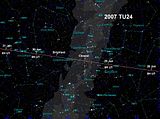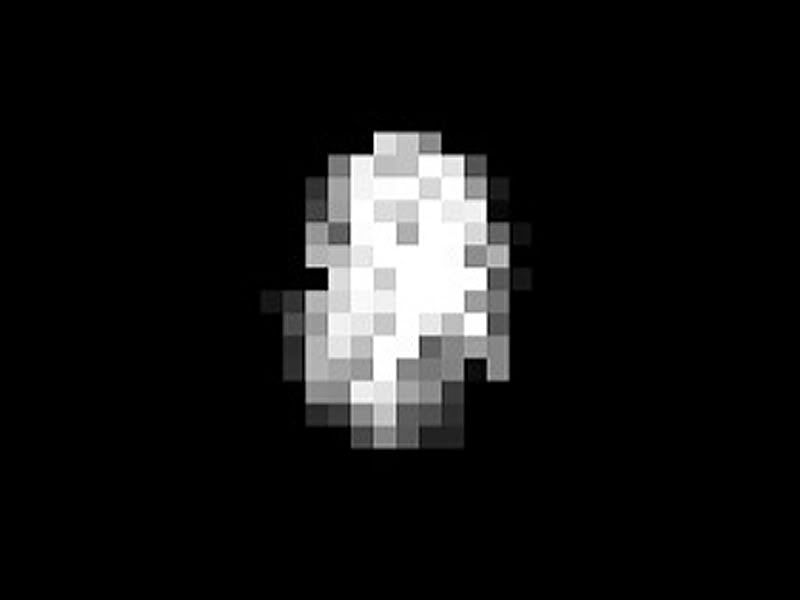Asteroid, Does any know where and when?
- Thread starter Joycecwilliams
- Start date
You are using an out of date browser. It may not display this or other websites correctly.
You should upgrade or use an alternative browser.
You should upgrade or use an alternative browser.
ETA: typed this as you replied.
Oh, yeah, 2007 TU24 which will pass at its closest on 29th January. You'll need a fairly decent telescope, at least 3" and a nice dark place to see it from.
If you're in the northern hemisphere, you'll need to look north-west, after midnight between the constellations of Perseus and Cassiopeia. It will be a (very) faint object (about mag 10.3) so you really do need a telescope. For comparison, Polaris, the north star which is relatively feint in light-polluted skies is about mag 1.96.
Here's a sky map with the asteroid's path over the next few days.

Oh, yeah, 2007 TU24 which will pass at its closest on 29th January. You'll need a fairly decent telescope, at least 3" and a nice dark place to see it from.
If you're in the northern hemisphere, you'll need to look north-west, after midnight between the constellations of Perseus and Cassiopeia. It will be a (very) faint object (about mag 10.3) so you really do need a telescope. For comparison, Polaris, the north star which is relatively feint in light-polluted skies is about mag 1.96.
Here's a sky map with the asteroid's path over the next few days.

Although according to that sky map, it is brightest later in the evening so you may need to wait until later in the night and find it in the sky below Polaris and to the right of Cameloparadalis.
I've got a pretty decent scope but I probably won't look for it. It won't look much different to a small star except it'll move across the sky as you observe it.
I've got a pretty decent scope but I probably won't look for it. It won't look much different to a small star except it'll move across the sky as you observe it.
Last edited:
- Joined
- Jul 6, 2006
- Messages
- 2,692
- Reaction score
- 942
- Location
- West Vir-freaking-ginia
- Website
- tsuki-explodes.blogspot.com
If you really wanna see an asteroid, wait until April 13, 2029 and go to the UK. That's when the asteroid "Apophis" is coming around. Rumor has it that it'll dip below our satelites when it comes, so that'll be a show that's well worth the wait, in my opinion.
Last edited:
Apophis will slip below geosynchronous satellites but those are the ones up in very high orbits, at a distance of about 35,000 kms - still uncomfortably close for an asteroid to pass by but far enough to make it pretty lackluster when it does. It's hard to predict exactly where it'll go and how bright it'll be twenty one years from now but estimates put it at mag 3 which, if you live in an urban neighbourhood, is what a feint star looks like with the naked eye. If you've ever seen a man-made satellite crossing the sky (fairly bright star moving slowly but steadily from horizon to horizon) then it'll probably resemble something like that.
No flames, smoke trails or multi-coloured shockwaves, unfortunately. At least, not yet.
No flames, smoke trails or multi-coloured shockwaves, unfortunately. At least, not yet.
Last edited:
It's almost certainly visible with binoculars, such as the 'standard' popular 7x50 size. The smaller 7x35's are weaker as far as gathering light, but still much better than the unaided eye. I have some 11x80 astronomical binoculars which are wonderful for this sort of thing. I saw that weird comet a couple months ago that "exploded" and became a million times brighter than before, becoming visible to the naked eye. It looked like just another star to my eye, but it appeared to be a pingpong ball (a very strange sight) in my binocs.Although according to that sky map, it is brightest later in the evening so you may need to wait until later in the night and find it in the sky below Polaris and to the right of Cameloparadalis.
I've got a pretty decent scope but I probably won't look for it. It won't look much different to a small star except it'll move across the sky as you observe it.
"oncomfortably close" - that's incredibly close for these things, about 1/10th the distance to the moon, and only about three Earth diameters away.Apophis will slip below geosynchronous satellites but those are the ones up in very high orbits, at a distance of about 35,000 kms - still uncomfortably close for an asteroid to pass by but far enough to make it pretty lackluster when it does.
It's possible (though unlikely, because both the asteroid and the satellites are small relative to the distances between them) for it to hit a satellite. That would be dramatic, especially for those watching DirecTV or whatever, when the TV suddenly and permanently shows "no signal received" for millions of TV viewers. It might make a small but interesting flash of light from the asteroid for those seeing it at the moment.It's hard to predict exactly where it'll go and how bright it'll be twenty one years from now but estimates put it at mag 3 which, if you live in an urban neighbourhood, is what a feint star looks like with the naked eye. If you've ever seen a man-made satellite crossing the sky (fairly bright star moving slowly but steadily from horizon to horizon) then it'll probably resemble something like that.
No flames, smoke trails or multi-coloured shockwaves, unfortunately. At least, not yet.
ETA: typed this as you replied.
Oh, yeah, 2007 TU24 which will pass at its closest on 29th January. You'll need a fairly decent telescope, at least 3" and a nice dark place to see it from.
If you're in the northern hemisphere, you'll need to look north-west, after midnight between the constellations of Perseus and Cassiopeia. It will be a (very) faint object (about mag 10.3) so you really do need a telescope. For comparison, Polaris, the north star which is relatively feint in light-polluted skies is about mag 1.96.
Here's a sky map with the asteroid's path over the next few days.

Thanks! Got the telescope and live in the country on top of a mountain. The town I live in has a population of 750 people... so light pollution is not a problem.
Thanks so much!
It's almost certainly visible with binoculars, such as the 'standard' popular 7x50 size. The smaller 7x35's are weaker as far as gathering light, but still much better than the unaided eye. I have some 11x80 astronomical binoculars which are wonderful for this sort of thing. I saw that weird comet a couple months ago that "exploded" and became a million times brighter than before, becoming visible to the naked eye. It looked like just another star to my eye, but it appeared to be a pingpong ball (a very strange sight) in my binocs.
Comet Homles was enormous when it erupted, at its maximum, wider even than the sun and so readily visible in scopes, bins or the naked eye even at a distance of 150 million miles away. TU24 is tiny, about 250 metres and so will not look like anything except a small star in telescopes and at magnitude 10.6, it's certainly too feint to see with the naked eye and according to this, too feint to be seen with your 7x50 binoculars - I don't know about your 11x80s. I think they're probably within range, to about mag 11.5 but you'll need to know where and when to look, what you're looking for and you'll need a very dark night away from any and all light pollution. Nasa recommends modest-sized telescopes.
"oncomfortably close" - that's incredibly close for these things, about 1/10th the distance to the moon, and only about three Earth diameters away.
Hey, you're preaching to the choir, man. I bet it happens a lot more than we know.
It's possible (though unlikely, because both the asteroid and the satellites are small relative to the distances between them) for it to hit a satellite. That would be dramatic, especially for those watching DirecTV or whatever, when the TV suddenly and permanently shows "no signal received" for millions of TV viewers. It might make a small but interesting flash of light from the asteroid for those seeing it at the moment.
It would certainly be annoying to have your tv signal knocked out by an asteroid. There are about 300 geosynchronous satellites in orbit at the moment so chances are low of a collision. As the date of passing nears, the trajectory will be known with far greater certainty than it is now and if a possible impact is detected, maybe they'll be able to alter the satellite's orbit to avoid losing it.
Last edited:
For anyone interested, this is a radar image of the asteroid that passed by Earth recently. It's about 250 metres in diameter and passed just outside the orbit of the moon. The image was taken by the Arecibo radio telescope in Puerto Rico.


That image looks more like cubism artwork...or even a structure made of Legos!
I like stuff like that. It's the sort of thing you can display but have people not know what it is.
I see a jellyfish/squid type creature with eyes in the back of its head.
I see a jellyfish/squid type creature with eyes in the back of its head.
You mean the telescope got Rllgthunder by mistake?
You mean the telescope got Rllgthunder by mistake?
Hmm... I don't think so. You can see from the darker pixels that this object casts shadows.
- Joined
- Apr 26, 2005
- Messages
- 23,708
- Reaction score
- 10,657
- Location
- In a world of my own making
- Website
- shadowferret.wordpress.com
You sure that's just not a screensnap of the game Asteroids?
It's the real thing, I promise. At these scales, it would be like trying to find an object the size of Donald Trump's skyscraper at over 350,000 kms away. Pretty incredible considering.

